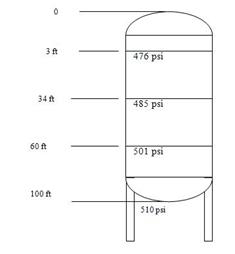What is Maximum Allowable Working Pressure?
The ASME maximum allowable working pressure (MAWP) for the pressure vessel is calculated by pressure vessel manufacturer. The design pressure is different from MAWP. The design pressure is provided by the purchaser (Owner /User) but the MAWP shall be provided by the manufacturer and must be indicated in the design document and pressure vessel nameplate.
The MAWP is covered in I4I Academy API 510 Pressure Vessel Inspector Training Courses, ASME Training course, and API source Inspector fixed equipment training course.
What is the ASME Maximum Allowable Working Pressure calculation process?
The design pressure is the maximum expected pressure and normally determined by purchase process engineer. Now, the manufacturer will use following formula to calculate wall thickness:

P in this formula is design pressure (provided by the purchaser), R inside radius of the pressure vessel ( provided by the purchaser). The S is allowable stress at the design temperature for selected material and can be obtained from a table in the ASME Section II Part D.
The E is joint efficiency and refers to the level of radiography and can be considered 1 for full radiography. Now you have everything to calculate your wall thickness.
Your wall thickness for 200 PSI design pressure with 60 inch inside diameter and 20,000 PSI allowable stress with joint efficiency 1 will be 0.6 inch. If you put these values in above formula, you will get this 0.6 inch wall thickness.
Now go to the market, is it any plate material with 0.6 inch? No the nearest one that you can find is the plate with 0.75 inch.

You need to get some credit fo using a plate with higher thickness.
Let us reverse above formula. You have the wall thickness, and you want to calculate P.
Put the same value in the formula except for design pressure and calculate P. This P will be your MAWP. So for above example, the MAWP will be 248 PSI. The 248 PSI is the MAWP and will go to the nameplate and will be the base for calculation of test pressure for hydrostatic test pressure.
As you can see, your maximum allowable working pressure always is greater than design pressure. In the worse case scenario that can be equal to design pressure but never will be less than that.
What is vessel MAWP and Part MAWP?

Based on UG-98 on the ASME Section VIII Div. 1, the vessel MAWP is the lowest part MAWP, and it is in topmost point of the vessel.
Look at the following sketch as you come down, your part MAWP is increasing. Why? Because of the static head. The question is that which of the following MAWP's will be in the design document and nameplate? The answer is the one which is in the topmost of the vessel and is lowest of the other part MAWP.
Conclusion: The purchaser provides, the design pressure and temperature and manufacturer is responsible for making the calculation and provide the vessel MAWP. The hydrostatic testing also will be based on MAWP and not design pressure.
Please note this apply to the pressure vessel only. For instance, in process piping based on ASME B31.3, we do not calculate the MAWP and everything will be based on the design pressure.
Free newsletter!
Sign up to receive my monthly newsletter covering all the latest courses and updates.




New! Comments
Have your say about what you just read! Leave me a comment in the box below.